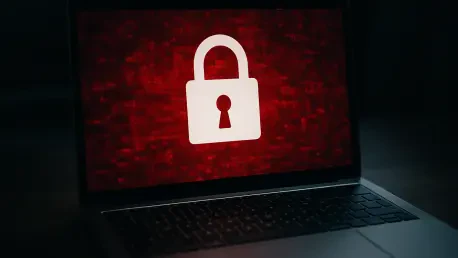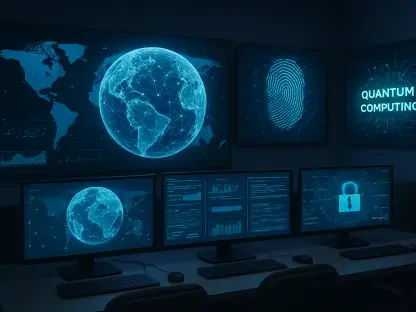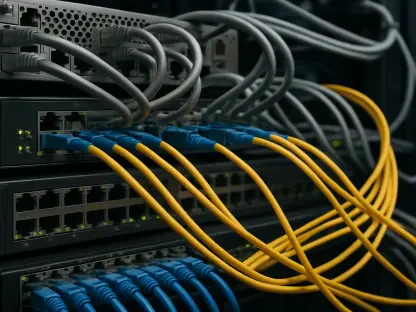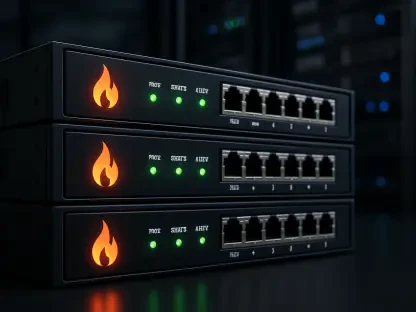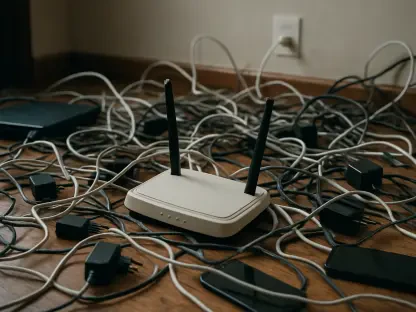In a digital landscape where cyber threats evolve at breakneck speed, a recent ransomware campaign has emerged as a particularly alarming example of how quickly attackers can strike and devastate organizational defenses. Targeting SonicWall firewalls, widely deployed for secure remote access through SSL VPNs, the Akira ransomware campaign has demonstrated an unprecedented ability to breach networks and deploy encryption in under an hour. Detailed in a comprehensive report by Arctic Wolf Labs, this aggressive operation, active since late July, showcases a “smash and grab” approach that leaves little room for traditional response mechanisms. The speed and efficiency of these attacks underscore a critical shift in ransomware tactics, where dwell time is minimized to mere minutes, forcing cybersecurity professionals to rethink their strategies. This campaign not only exploits known vulnerabilities but also leverages stolen credentials and sophisticated tools to bypass even robust safeguards like multi-factor authentication (MFA). As organizations across various sectors fall victim to this opportunistic assault, the urgency to understand and counter these rapid intrusions has never been greater. The following exploration delves into the mechanisms behind this threat, the tactics employed by attackers, and the defensive measures needed to mitigate such fast-moving risks.
The Speed of Akira Attacks
Smash and Grab: A New Ransomware Model
The defining characteristic of the Akira ransomware campaign lies in its lightning-fast execution, often completing an attack from initial breach to full encryption in less than an hour, starkly contrasting with traditional ransomware operations where attackers might spend days or weeks mapping networks and exfiltrating data before striking. The “smash and grab” model adopted by Akira operators prioritizes speed over stealth, relying on pre-compromised credentials and automated tools to penetrate systems with ruthless efficiency. Such a compressed timeline means that by the time many organizations detect an anomaly, their critical data is already encrypted or stolen. This approach exploits the inherent delays in manual incident response, catching defenders off guard and highlighting the limitations of reactive security postures. The urgency for real-time monitoring and automated threat detection becomes evident when facing adversaries who operate within a window as narrow as 55 minutes.
Further amplifying the challenge is the strategic intent behind this rapid-fire methodology, which attackers seem to rely on to overwhelm defenses before any meaningful counteraction can be mounted. This tactic aligns with broader trends in cybercrime toward automation and scalability. By minimizing dwell time, Akira operators reduce their exposure to detection, making it harder for security tools to flag suspicious behavior in the brief moments they are active. This shift signals a growing preference among ransomware groups for high-speed, high-volume attacks over prolonged, targeted campaigns. For organizations relying on SonicWall devices, this means that even a momentary lapse in vigilance can result in catastrophic consequences. The need for proactive measures, such as continuous monitoring of VPN logins and immediate alerting on unusual activity, has become non-negotiable in the face of such a relentless pace.
Accelerated Attack Timelines and Industry Implications
The breakneck speed of the Akira campaign reflects a broader evolution in ransomware strategies, where accelerated timelines are becoming the norm rather than the exception, highlighting a critical shift in cyber threats. Unlike past incidents where threat actors lingered to maximize reconnaissance, these attackers deploy their payloads almost immediately after gaining access, often within minutes. This urgency is driven by the availability of stolen credentials and pre-configured attack scripts that allow for rapid exploitation across a wide range of targets. Arctic Wolf Labs notes that the entire process—from initial VPN login to data encryption—can unfold in under four hours, with some instances clocking in at under an hour. Such efficiency demands a fundamental shift in how cybersecurity teams operate, as traditional incident response frameworks are ill-equipped to handle threats that materialize and execute so swiftly.
Beyond the immediate impact on victims, this trend of accelerated attacks carries significant implications for the cybersecurity industry at large, highlighting a critical need for advanced defensive strategies. The reliance on automation by Akira operators points to a future where manual interventions will increasingly fall short against machine-driven assaults. Organizations must invest in technologies that match this speed, such as automated threat detection systems and machine learning algorithms capable of identifying anomalies in real time. Additionally, the compressed attack window underscores the importance of preparedness, including regular drills for rapid response and recovery. As ransomware groups continue to refine their tactics for speed, the gap between attacker efficiency and defender readiness widens, placing unprecedented pressure on security teams to adapt or risk being outpaced by threats like Akira.
Exploiting SonicWall Vulnerabilities
CVE-2024-40766 and Credential Theft
At the heart of the Akira ransomware campaign is the exploitation of a known vulnerability in SonicWall firewalls, identified as CVE-2024-40766, which involves improper access control in older firmware versions. Although patches have been available, the lingering risk stems from credentials likely harvested during periods when devices remained unpatched. Attackers use these stolen credentials to access SSL VPN services, even on systems updated to newer SonicOS versions. This persistent threat illustrates a critical gap in post-patch security: firmware updates alone cannot mitigate the danger posed by previously compromised login details. Organizations that fail to reset credentials after addressing vulnerabilities leave themselves exposed to attacks that exploit historical weaknesses, a tactic Akira operators have mastered with devastating effect.
The mechanics of this exploitation reveal a calculated approach by threat actors who capitalize on past oversights to gain current access, highlighting a critical vulnerability in cybersecurity practices. Arctic Wolf Labs suggests that credentials obtained through earlier breaches of SonicWall devices are systematically reused, targeting both local firewall accounts and Active Directory accounts synchronized with LDAP. This method allows attackers to bypass the protective barrier of updated systems, underscoring the importance of comprehensive credential hygiene. Beyond simply patching devices, there is an urgent need to audit and refresh all potentially exposed login information. Without such measures, the shadow of past vulnerabilities continues to loom large, providing a gateway for rapid intrusions that can cripple networks before defenses are mobilized.
MFA Bypass Concerns
One of the most troubling aspects of the Akira campaign is its apparent ability to bypass multi-factor authentication (MFA), a security measure long considered a cornerstone of robust access control. Arctic Wolf Labs reports that over half of the analyzed intrusions involved successful logins to accounts with one-time password (OTP) MFA enabled, often within minutes of the authentication challenge. While the exact mechanism—whether through stolen OTP seeds, social engineering, or another undisclosed method—remains unclear, the implications are profound. This capability erodes trust in MFA as a standalone safeguard, exposing a vulnerability that attackers exploit with alarming consistency to gain initial access to SonicWall VPNs.
The uncertainty surrounding MFA bypass methods heightens the urgency for organizations to reassess their authentication frameworks and take proactive measures to safeguard their systems. Relying solely on MFA without complementary protections, such as regular credential resets and monitoring for anomalous login patterns, leaves a critical weak point that Akira operators are adept at targeting. The campaign’s success in this area also suggests a need for alternative authentication strategies, such as Single Sign-On (SSO) or SAML-based systems, which have shown no evidence of malicious logins in this context. Strengthening identity management practices and integrating layered security controls are essential steps to counter the sophisticated techniques employed by these threat actors, ensuring that access points are not easily compromised even when primary defenses are challenged.
Attack Tactics and Techniques
Rapid Discovery and Lateral Movement
Once inside a network through SonicWall VPNs, Akira operators waste no time, initiating discovery and lateral movement within minutes of gaining access. Using tools like Impacket, SoftPerfect Network Scanner, and Advanced IP Scanner, attackers swiftly map out internal systems, targeting ports associated with critical services such as RPC, SMB, and SQL. This rapid reconnaissance allows them to identify high-value assets and vulnerabilities with precision, often operating from temporary directories like %Temp% or Downloads on compromised servers. The speed of this phase—sometimes as quick as five minutes—demonstrates a highly automated approach that leaves little opportunity for detection, setting the stage for broader network compromise.
Lateral movement follows just as quickly, with attackers leveraging stolen credentials to navigate through systems via Remote Desktop Protocol (RDP) and SMB/Windows Admin Shares. Tools such as nltest, PowerShell cmdlets, and open-source utilities like BloodHound are employed to enumerate Active Directory and map network relationships, pinpointing critical servers and domain controllers. This systematic progression enables threat actors to escalate privileges and access sensitive areas of the environment in record time. For defenders, this underscores the necessity of network segmentation and strict access controls to slow down such rapid internal spread, as well as continuous monitoring for unusual RDP or SMB activity that could signal an ongoing breach.
Data Exfiltration and Encryption
Parallel to their swift movement across networks, Akira attackers prioritize data exfiltration as a core component of their dual extortion strategy. Sensitive information is systematically staged using WinRAR, with installers placed on file servers and domain controllers to compress recent and valuable files into archives for theft. Specific parameters ensure that only critical data, such as documents and text files from the past year, are targeted, often split into manageable sizes for efficient transfer. Tools like Rclone and FileZilla facilitate the upload to attacker-controlled servers, amplifying the threat of data leaks alongside encryption and adding immense pressure on victims to comply with ransom demands.
Following data theft, the deployment of Akira ransomware seals the attack with encryption, appending extensions like .akira to locked files. This phase, often completed within the same tight timeline of under an hour, ensures that systems are rendered inaccessible, compounding the damage from exfiltrated data. The dual impact of losing access to critical operations and facing potential public exposure of stolen information creates a lose-lose scenario for affected organizations. To mitigate such outcomes, monitoring for large, unusual file transfers and implementing endpoint detection for suspicious tool execution, such as WinRAR from atypical locations, are vital steps to intercept data staging before it escalates to full encryption and loss.
Defense Evasion and Persistence
Disabling Security Tools
A hallmark of the Akira campaign is its sophisticated defense evasion tactics, designed to neutralize security measures and operate undetected within compromised environments. Attackers actively disable endpoint detection and response (EDR) systems, Windows Defender, and other protective tools through a variety of methods, including bring-your-own-vulnerable-driver (BYOVD) attacks. By exploiting legitimate but vulnerable drivers to gain kernel-level access, they tamper with access control lists (ACLs) and shut down security processes, often hiding malicious components in directories mimicking trusted software names. This deliberate undermining of defenses ensures that their activities go unnoticed during the critical early stages of an attack.
Additionally, threat actors employ registry modifications to bypass User Account Control (UAC) restrictions, allowing remote execution with full administrative privileges. Commands are issued to disable real-time monitoring and behavior scanning, while Volume Shadow Copy snapshots are deleted to hinder recovery efforts. These calculated moves reflect a deep understanding of defensive technologies and a strategic intent to cripple response capabilities. For organizations, countering such tactics requires a layered security approach, incorporating application control policies like Windows Defender Application Control (WDAC) to block unauthorized drivers and continuous monitoring for unauthorized registry changes that could signal an attempt to disable critical safeguards.
Long-Term Access Mechanisms
Beyond evading detection, Akira operators establish persistence to maintain long-term access to compromised networks, ensuring they can return even after initial mitigation efforts. This is achieved through the creation of local and domain administrator accounts with innocuous names like “sqlbackup,” designed to blend into the environment and avoid suspicion. These accounts are often elevated to high-privilege groups, granting attackers unfettered control over critical systems. Such persistence mechanisms pose a sustained threat, as they allow repeated intrusions long after the initial breach has been addressed, complicating the full eradication of the attacker’s foothold.
To complement these accounts, remote management tools such as AnyDesk, TeamViewer, and RustDesk are installed for ongoing access, typically downloaded via PowerShell to user directories or ProgramData folders. Additionally, SSH reverse tunnels and Cloudflare Tunnel clients are configured to bypass network address translation (NAT) restrictions, ensuring connectivity despite defensive network changes. These tools and techniques highlight the importance of strict software installation controls and monitoring for unauthorized remote access applications. Regular audits of administrator accounts and immediate action to remove unrecognized or suspicious entries are crucial to disrupt the long-term presence of attackers within a network, preventing recurring exploitation.
Strategic Targeting and Motives
Backup Systems as Prime Targets
A particularly destructive element of the Akira campaign is its focus on backup systems, with a specific emphasis on platforms like Veeam Backup & Replication, to maximize damage and ransom potential. Attackers target these systems to extract credentials stored in SQL databases, often using custom PowerShell scripts to automate the process across MSSQL and PostgreSQL backends. By decrypting passwords with retrieved encryption salts and temporarily altering configuration files for access, they gain domain credentials and access to virtual machine (VM) storage. This not only aids in data theft but also critically impairs recovery capabilities, leaving organizations with few options to restore operations without capitulating to demands.
The strategic targeting of backups underscores a broader trend in ransomware operations where disrupting recovery is as important as encryption itself, highlighting the critical need for robust defense mechanisms. By deleting snapshots and compromising backup integrity, Akira operators ensure that even well-prepared entities face significant hurdles in bouncing back. This tactic amplifies the pressure to pay ransoms, as the alternative involves prolonged downtime and potential data loss. Protecting backup systems with stringent access controls, encryption, and offline storage becomes paramount in this context. Immutable backups and restricted permissions can serve as vital defenses, safeguarding recovery mechanisms against attackers who view them as high-value targets for sabotage and escalation.
Geofencing and Selective Operations
An intriguing aspect of the Akira campaign lies in its use of geofencing within malicious components, particularly in BYOVD attacks, to avoid execution in specific regions such as parts of Eastern Europe and Central Asia. Malicious DLLs check system locales and terminate if they match a predefined list, indicating a deliberate choice to limit operations to certain geographic areas. While not uncommon in ransomware to evade scrutiny or retaliation from particular state actors, this early-stage geofencing—occurring during defense evasion rather than encryption—suggests a nuanced strategy. It hints at potential geopolitical considerations or affiliations guiding the attackers’ scope and target selection.
This selective targeting raises questions about the broader motivations behind the campaign, beyond mere financial gain, and whether safe havens or strategic alliances are influencing where Akira operators choose to strike. While definitive answers remain elusive, the presence of such tactics points to a calculated approach that balances risk and reward on a global scale. For organizations, this does not diminish the threat, as most regions remain fair game under this opportunistic model. However, it emphasizes the importance of understanding attacker behavior and motivations to anticipate potential blind spots or areas of focus. Global vigilance, coupled with localized intelligence on cybercriminal patterns, can help tailor defenses to address the specific risks posed by campaigns employing such selective operational constraints.
Critical Defenses Against Rapid Threats
Proactive Credential and VPN Monitoring
Given the speed and reliance on stolen credentials in the Akira ransomware campaign, proactive measures to secure access points are essential for organizations using SonicWall devices. Resetting all SSL VPN and Active Directory credentials potentially exposed through past vulnerabilities must be a priority, as outdated or compromised login details remain a primary entry vector for attackers. This step, though basic, addresses the persistent risk of historical breaches being exploited long after patches are applied. Additionally, regular audits of credentials and immediate rotation following any suspicion of exposure can significantly reduce the likelihood of successful unauthorized access, closing a critical gap that Akira operators exploit with precision.
Equally important is the monitoring of VPN logins for suspicious origins, particularly those tied to hosting-related Autonomous System Numbers (ASNs) or virtual private server (VPS) infrastructure, which are rarely used for legitimate business purposes. Arctic Wolf Labs highlights that malicious logins often originate from a handful of identifiable sources, making it feasible to block or flag access attempts from untrusted regions or providers. Implementing geo-restrictions and real-time alerting on anomalous login patterns can provide an early warning system, buying precious seconds in a threat landscape where every moment counts. Adopting SSO or SAML for VPN authentication, which have shown no evidence of compromise in this campaign, offers another layer of protection, reducing reliance on potentially vulnerable MFA implementations.
Strengthening Detection and Recovery Capabilities
To counter the rapid progression of Akira attacks, organizations must enhance detection capabilities through network and endpoint monitoring tailored to the specific tools and behaviors exhibited by these threat actors. Network-based detection of Impacket SMB activity, often used for internal scanning and lateral movement, can serve as an early indicator of compromise. Similarly, endpoint monitoring for suspicious executions—such as WinRAR running from unusual locations like %Temp%—can flag data staging attempts before exfiltration occurs. These measures, supported by automated threat detection systems, are critical to keeping pace with attackers who operate within compressed timelines, ensuring that anomalies are identified and acted upon before full encryption takes hold.
Recovery capabilities also demand urgent attention, particularly in light of attackers’ focus on disabling backups to hinder restoration and prolong the impact of their assaults. Securing backup systems like Veeam with tight access controls, encryption, and offline storage options can preserve critical recovery mechanisms against targeted sabotage. Immutable backups, which prevent deletion or alteration, offer a robust safeguard against tactics like the deletion of Volume Shadow Copy snapshots. Beyond technical defenses, regular testing of disaster recovery plans ensures that teams are prepared to respond swiftly and effectively, minimizing downtime even if an attack succeeds. By treating backups as high-value assets and integrating layered security, organizations can build resilience against the dual extortion model that defines Akira’s destructive approach.
Adapting to Evolving Ransomware Trends
Reflecting on the Akira campaign, it became evident that the shift toward faster, automated ransomware attacks required a corresponding evolution in defensive strategies. The emphasis on speed over stealth, as seen in these intrusions, challenged conventional security models and forced a reevaluation of response timelines. Organizations that adapted by investing in real-time monitoring and automated detection tools were better positioned to intercept threats before they escalated. This adaptation proved crucial in an era where manual processes could not match the pace of machine-driven assaults, offering a blueprint for addressing similar threats that emerged in subsequent campaigns.
Looking ahead, the lessons from these attacks pointed to actionable steps for bolstering defenses against the next wave of rapid ransomware, emphasizing the need for robust security measures. Prioritizing credential hygiene through regular resets and exploring safer authentication methods like SSO remained a foundational necessity. Strengthening backup security with immutable and offline solutions ensured recovery options stayed viable, while continuous monitoring for suspicious VPN logins and internal network activity helped catch intrusions early. As ransomware tactics continued to evolve, fostering a culture of proactive vigilance and cross-industry collaboration became essential, equipping defenders with the insights needed to anticipate and mitigate future risks in an increasingly hostile digital environment.
